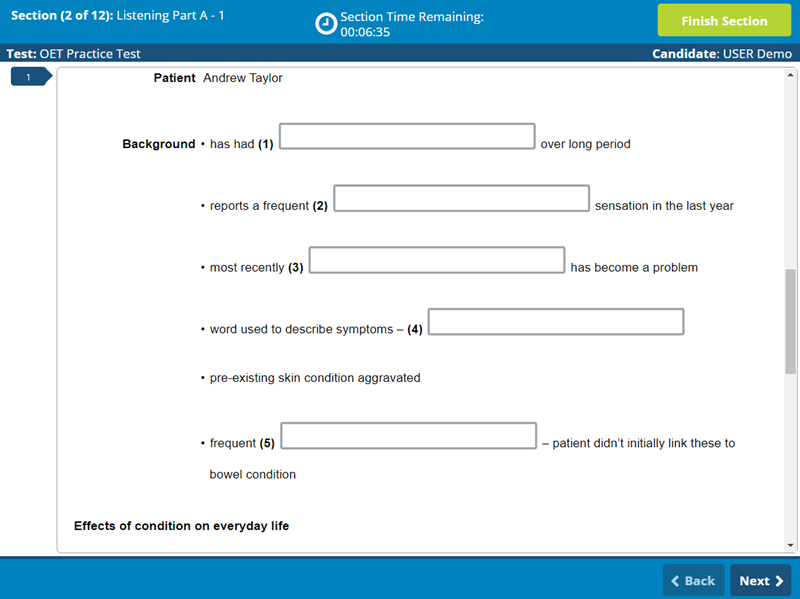
OET Listening Part A simulates a healthcare consultation where a health professional talks to a patient. In this blog post, you’ll learn the format of the OET Listening Part A test, understand the skills that are being tested, review sample questions, and see some test tips and recommendations for Part A preparation.
OET Listening Part A Format:
Here's an outline of the Listening Part A format.
- Two audio recordings
- Healthcare professional + patient
- 4-5 minutes each
- 12 questions per extract
- Note completion
In OET Listening Part A, you’ll hear two different audio recordings. In each recording, a health professional is talking to a patient. Each audio is approximately 4.5 - 5 minutes long and has 12 questions.
These questions require you to complete a set of healthcare professional’s notes with a word or short phrase that you hear in the audio.
Check out official OET sample tests here: sample OET Listening Tests
Skills for OET Listening Part A:
In your workplace, you often need to gather information from patients or clients. To ensure safe and effective care, you need to do this accurately. Part A simulates this by using audio extracts from healthcare consultations. It focuses on your ability to listen for detail, to comprehend, interpret and accurately record detailed spoken information.
Sample Questions:
For OET on paper, your questions are printed on a page. Notice the context statement (‘You hear a gastroenterologist…’) and instructions to complete the notes with a word or short phrase that you hear.

The questions are displayed in the format of a healthcare professional’s notes. There are headings and some extra text, plus the questions themselves, the gaps.

You have 30 seconds to look at the notes before the audio starts playing. You only hear the recording once, so you need to complete the answers while you listen.
For OET on computer, the layout is the same, but you type your answers in as you listen.

OET Listening Part A on computer
When extract 1 is finished, you move on to extract 2 where you’ll again have 30 seconds to read the notes.
Did you know? OET Listening Part A is marked by human assessors, so make sure your writing is legible if you’re doing the test on paper. UK and US spellings are accepted and minor spelling variations may be accepted, as long as the intended meaning is clear.
Test Tips for Listening Part A:
Here are some tips you can follow to help you in OET Listening Part A:
1) Write only what you hear.
Your answers should come directly from the audio and they’re generally between one and three words. For instance, in this question, you’re listening for who the patient was referred to. (Extract taken from Listening Sample Test 1),

The speaker says:
‘Err, then the GP sent me to see an osteopath and I got some treatment there, but it didn’t seem to make much difference.’
You should write only what you heard exactly – osteopath or an osteopath are acceptable answers. You mustn’t change the word form or add extra words.
2) Use the headings and the extra text to help you.
The extra text on the question sheet will help you to keep up with the conversation. Everything that is written will be mentioned in order, usually not with the same words though. The questions come in order too. Use the text around the questions to predict the kind of word or phrase you’ll hear. For instance, in this question, ‘Patient’s description of symptoms, pain located in’, you can guess that the pain is located in a particular place on the patient’s body.

3) Check your answer makes logical and grammatical sense.
If the answer makes no sense, it’s wrong. For the example above, the word ‘intense’ would be a grammatically wrong answer. And ‘America’ wouldn’t make sense logically. Use the time before the audio starts to consider what type of word goes in the gap.
4) If you miss a question, move on.
It’s better to keep moving with the audio, rather than stopping to worry about an answer you’re not sure of. Missing one question is better than missing 2, 3, 4 or more. As the audio moves on, move on with it.
Preparation recommendations:
To prepare for OET Listening Part A, you need to practise listening for details in healthcare consultations in English. Here are some ways you can do this:
1) Use your own workplace or use media like TV shows, documentaries and movies that involve healthcare.
Search for shows set in hospitals or clinics and study the language used.
Recommended shows:
- Grey’s Anatomy
- GPs Behind Closed Doors
- Embarrassing Bodies
2) Get to know accents.
You might hear a variety of accents in OET Listening so listening to podcasts or watching shows from a range of different countries like the USA, the UK, Australia and New Zealand will help you manage these different varieties.
Recommended podcasts:
3) Increase your knowledge of everyday language.
Get to know phrasal verbs, idiomatic language and everyday expressions. Keep a record of them and practise using them yourself.
4) Use practice test transcripts.
When you try a practice test, also make use of the transcript. You’ll find lots of useful language and be able to identify the paraphrase from the question sheet. Mine each transcript for new words and phrases to learn.
Getting ready for Listening Part A will help you be your best in an English-speaking healthcare workplace in the future. Keep practising and use resources like the OET Blog and YouTube channel to learn from OET experts.
Links for further practice:
OET Listening Part A on-demand lessons (YouTube)
Check out our other Listening Guides: